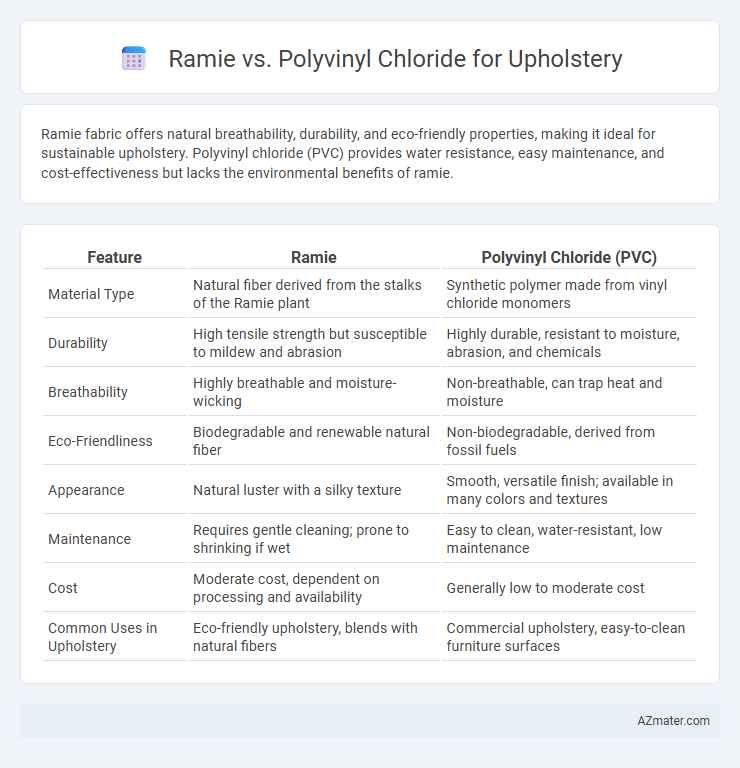Ramie fabric offers natural breathability, durability, and eco-friendly properties, making it ideal for sustainable upholstery. Polyvinyl chloride (PVC) provides water resistance, easy maintenance, and cost-effectiveness but lacks the environmental benefits of ramie.
Table of Comparison
| Feature | Ramie | Polyvinyl Chloride (PVC) |
|---|---|---|
| Material Type | Natural fiber derived from the stalks of the Ramie plant | Synthetic polymer made from vinyl chloride monomers |
| Durability | High tensile strength but susceptible to mildew and abrasion | Highly durable, resistant to moisture, abrasion, and chemicals |
| Breathability | Highly breathable and moisture-wicking | Non-breathable, can trap heat and moisture |
| Eco-Friendliness | Biodegradable and renewable natural fiber | Non-biodegradable, derived from fossil fuels |
| Appearance | Natural luster with a silky texture | Smooth, versatile finish; available in many colors and textures |
| Maintenance | Requires gentle cleaning; prone to shrinking if wet | Easy to clean, water-resistant, low maintenance |
| Cost | Moderate cost, dependent on processing and availability | Generally low to moderate cost |
| Common Uses in Upholstery | Eco-friendly upholstery, blends with natural fibers | Commercial upholstery, easy-to-clean furniture surfaces |
Introduction to Upholstery Materials
Ramie, a natural fiber derived from the stalk of the Chinese grass plant, is prized for its breathability, durability, and eco-friendly properties in upholstery applications. Polyvinyl chloride (PVC), a synthetic plastic polymer, offers high resistance to moisture, chemicals, and abrasion, making it a popular choice for easy-to-clean and long-lasting upholstery. Choosing between ramie and PVC involves balancing natural texture and sustainability against synthetic resilience and maintenance convenience in upholstery materials.
Overview of Ramie Fabric
Ramie fabric, derived from the fibers of the Ramie plant (Boehmeria nivea), is a natural textile known for its strength, durability, and breathability, making it an excellent choice for upholstery. Unlike polyvinyl chloride (PVC), which is a synthetic plastic polymer often used for its waterproof and easy-to-clean properties, Ramie offers a biodegradable and eco-friendly alternative with a linen-like texture. Its resistance to mildew, ability to hold shape, and capacity to absorb dyes well contribute to its growing popularity in sustainable and high-end furniture upholstery.
Understanding Polyvinyl Chloride (PVC)
Polyvinyl chloride (PVC) is a synthetic polymer widely used in upholstery for its durability, water resistance, and ease of cleaning. Unlike natural fibers such as ramie, PVC offers superior resistance to stains and wear, making it ideal for high-traffic furniture. Its versatility allows for various textures and finishes, enhancing aesthetic appeal while maintaining low-maintenance functionality.
Durability Comparison: Ramie vs PVC
Ramie fibers boast high tensile strength and natural resistance to wear, making them durable for upholstery but prone to moisture-related degradation over time. Polyvinyl chloride (PVC) upholstery offers superior water resistance and exceptional durability against scratches, stains, and fading, making it ideal for heavy-use environments. While ramie provides breathability and strength, PVC's synthetic composition ensures longer-lasting performance under diverse conditions.
Comfort and Aesthetic Differences
Ramie fabric offers superior breathability and softness, contributing to enhanced comfort in upholstery compared to the synthetic, less breathable polyvinyl chloride (PVC). Aesthetically, ramie boasts a natural, textured appearance that adds warmth and elegance, while PVC provides a smoother, glossy finish often associated with modern and minimalist decor. The choice between ramie and PVC hinges on prioritizing natural comfort and classic appeal versus durability and ease of maintenance.
Environmental Impact and Sustainability
Ramie, a natural fiber derived from the stalks of the Chinese grass plant, offers high biodegradability and low environmental impact compared to polyvinyl chloride (PVC), a synthetic plastic known for its persistence and toxic production processes. The cultivation of ramie requires fewer chemical inputs and releases less carbon dioxide, making it a more sustainable option for upholstery fabrics. In contrast, PVC upholstery contributes to significant environmental pollution through harmful chlorine-based compounds and challenges in recycling, raising sustainability concerns.
Maintenance and Cleaning Requirements
Ramie upholstery requires gentle cleaning with mild detergents and regular vacuuming to prevent fiber damage and maintain its natural texture, as it is more prone to staining and moisture absorption. Polyvinyl chloride (PVC) upholstery offers superior maintenance ease due to its water-resistant and stain-repellent properties, allowing for quick wipe-downs with non-abrasive cleaners without risk of fiber degradation. While Ramie demands careful handling to avoid premature wear, PVC provides a durable, low-maintenance solution ideal for high-traffic or moisture-prone environments.
Cost Considerations
Ramie upholstery fabric generally incurs higher initial costs due to its natural fiber production and limited availability compared to polyvinyl chloride (PVC), which is a synthetic, cost-effective material often chosen for budget-friendly projects. PVC offers competitive pricing driven by mass production and durability, translating into lower maintenance and replacement expenses over time. Evaluating long-term cost efficiency, PVC can be more economical despite Ramie's eco-friendly appeal and premium aesthetic.
Popular Applications in Upholstery
Ramie fabric is widely used in upholstery for its natural luster, breathability, and durability, making it ideal for eco-friendly furniture in living rooms and lounges. Polyvinyl chloride (PVC) upholstery is popular in commercial settings like restaurants and healthcare due to its water resistance, easy maintenance, and excellent durability against wear and stains. Both materials cater to distinct needs: ramie is preferred for sustainable, breathable upholstery, while PVC suits heavy-use environments requiring hassle-free cleaning.
Choosing the Right Material for Your Needs
Ramie offers a natural, breathable, and durable fabric ideal for eco-friendly upholstery, while polyvinyl chloride (PVC) provides water resistance, easy maintenance, and longevity suited for high-traffic or spill-prone areas. Consider Ramie if sustainability and comfort are priorities, as its plant-based fibers promote biodegradability without sacrificing strength. Opt for PVC when durability, stain resistance, and cost-effectiveness are key, especially in commercial settings requiring frequent cleaning.

Infographic: Ramie vs Polyvinyl chloride for Upholstery
 azmater.com
azmater.com